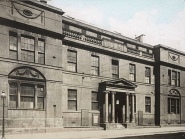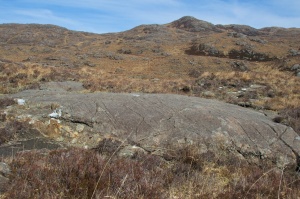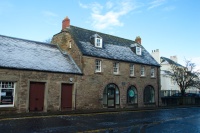 If someone asked you to name some famous Scottish scientists, who would you come up with? Alexander Fleming, James Young Simpson, Joseph Lister, James Hutton… but would you think of James Croll?
If someone asked you to name some famous Scottish scientists, who would you come up with? Alexander Fleming, James Young Simpson, Joseph Lister, James Hutton… but would you think of James Croll?
I’ve got to admit that, until just recently, I certainly wouldn’t. But this man was a phenomenon in his own era, a largely self-taught scientist who meditated so deeply on so many diverse questions – the age of the Sun, for instance, and the thickness of the Antarctic ice sheet – that it almost seems as if he plucked his theories out of some inner consciousness. Croll had a gift that combined intuition and intellect, and among the learned men who were startled into a deep respect for him were Charles Darwin, John Herschel and Alfred Wallace.
But at the beginning, it could have been so very different.
Born in 1821, James Croll and his family occupied a farm called Little Whitefield in the parish of Cargill, a few miles north of Perth; James’ father was a crofter and a stonemason. Shortly after James was born, his parents were evicted from their farm by an ambitious landlord, and given a much more humble cottage on a small area of wasteland: this was a time of ‘agricultural improvement’, and crofting tenants were often seen as a hindrance. Of James’ three brothers, only one lived to adulthood, but suffered physical deformity; and James himself was expected, after a brief village-school education, to follow his father into a life of manual labour. The problem was that his mind was occupied with other things.
From the age of about 12 or 13, James had pondered the deep questions about life, the universe and everything.
“I asked myself, what would there be, if there were no world? The ready answer, of course, was that there would be the sun, moon, and stars. What would there be, if there were no sun, moon and stars? There would be God. But what would there be if there were no God? There would be nothing but empty space. But if there were no space, what would remain? This question staggered me…”
‘Autobiographical Sketch of James Croll…’ by James Campbell Irons

Soon afterwards, he purchased a copy of the Penny Magazine from a shop in Perth, and when he had devoured its contents he began to look further afield, to the great thinkers of the day. And while he was eagerly getting to grips with the philosophical writings of Thomas Dick and the ‘Scientific Dialogues’ of Jeremiah Joyce, a more prosaic and pressing question was rearing its head: how was he going to earn a living? For the likes of James there was no chance of further education, the kind of schooling that would have fed his mind and propelled him into an academic institution, where he would have thrived; learning a trade, a respectable craftsman’s skill, was the best he could hope for.
It might have worked if James had been physically fit and mentally suited for the job; but he wasn’t. And he tried not one trade, but several. As a travelling millwright, walking long distances to repair threshing machines, he suffered terribly with injuries to his feet; and as a joiner, a painful abscess on his elbow joint soon forced him out of action. So he turned to shopkeeping, possibly figuring that a life behind a counter would be less demanding on the body: but he had neither the agility of manner nor the brightness of attitude for such a role. Unbelievably, he tried selling insurance, and even more unbelievably, he succeeded – largely because of his earnest approach, which his customers instinctively trusted. But those years, he later admitted ruefully, were the unhappiest of his life. Another idea, well-intended but doomed from the outset, was to open a Temperance hotel in Blairgowrie; but the town was already well-served with 16 taverns, and Croll’s alcohol-free hostelry failed to prosper.

What he desperately needed, of course, was a post in a college or university, but he had neither the qualifications nor the status to acquire one. And then, out of the blue, he was offered a job at the Anderson College in Glasgow – as a janitor.
“I have never been in any place so congenial to me as that institution proved…”
‘Ice Ages – Solving the Mystery’ by Imbrie and Imbrie
He might have been scrubbing floors and airing classrooms, but this was the chance that James had dreamed of. In his spare time, he immersed himself in the sea of learning and soaked it up like a sponge. Soon, he was writing his own scientific papers, and submitting them, rather tentatively, to the Philosophical Magazine. Scientists around the world began to wake up to the name of James Croll.
“At this period, the question of the cause of the Glacial epoch was being discussed with interest among geologists. In the spring of 1864 I turned my attention to this subject.”
James had never had much mathematical training, although in his twenties he had gone back to a local school for a few hours a week, specifically to learn a bit of algebra. There was a huge gulf of difference between this and appreciating the formulae of the French scientist Urbain Le Verrier, who had worked out the cycle of variations in the Earth’s elliptical orbit based on the pull of the other planets in the solar system. But Croll applied his mind to it, as he did to all things, and into the melting pot he also threw a few other statistics, such as the changes in the Earth’s axial tilt and the precession of the equinoxes. What he came up with was a cycle stretching back over three million years, which – he believed – proved that the Earth had experienced not one, but several ice ages; and he used it to show that it would do so again, entirely predictably, as it rolled around in its complex cosmic dance.
A few definitions
Axial tilt: This is the angle of the Earth’s tilt as it rotates on its axis, measured between the North Pole and a perpendicular line drawn at right angles to the plane of the Earth’s orbit. It fluctuates between 22.1° and 24.5° over a period of 41,000 years. Axial tilt is the main cause of the seasons in the northern and southern hemispheres.
Precession: If you imagine the Earth’s axis extending in a line above the North Pole like the pinnacle of a spinning top, and then imagine that the spinning top is wobbling slightly as it rotates, causing the line to describe a small circle in space, you will be seeing what is called precession. Occurring over a cycle of 26,000 years, it can cause severity or mildness of the Earth’s seasons when combined with other factors.
Orbital eccentricity: The Earth’s orbit around the Sun is very slightly elliptical, and the degree of deviation – its eccentricity – is caused largely by the pull of the other planets. When the Earth is furthest from the Sun, it is said to be at aphelion; when it is closest, it is at perihelion. At present, perihelion occurs about two weeks after the winter solstice in the northern hemisphere.
The plunge into an ice age…
Croll proposed, with remarkable intuition, that the spread of ice over the Earth’s surface was accelerated by the sun’s heat being reflected back into space; in effect, it was self-perpetuating. By this stage, he suggested, the planet’s ocean currents and wind patterns would have shifted out of all recognition.
Sixty years later, Croll’s theory provided a basis for the Milankovitch cycles, which describe the collective effects of the Earth’s motion upon its climate, calculated by the Serbian scientist Milutin Milankovitch.

Having mapped the cycle of glacial epochs through space and time, Croll now started to notice evidence of glaciation in his home country. In this he was supported by Archibald Geikie, a Scottish scientist who was himself fascinated by glaciology, and who offered James a post at the Geological Survey of Scotland. Bear in mind that this was 1864, and only three or four decades earlier most of these features had been ascribed to the Biblical flood; but Charles Darwin had flung open the doors to a new realm of science, and James Croll was riding on the ensuing wave of intense intellectual discussion. Even the great man himself had to concede a point or two to James Croll:
“I never fully realised the truth until reading your paper just received. How often I have speculated in vain on the origin of the valleys in the chalk platform round this place, but now all is clear. I thank you cordially for having cleared so much mist from before my eyes.”
Charles Darwin, quoted in ‘Autobiographical Sketch of James Croll… ’ by James Campbell Irons
In many men, the recognition that Croll was now receiving might have generated an unhealthy sense of self-importance; but he remained modest and retiring, conscious always of his own shortcomings. He strikes me as being like a ponderous old grandfather, wise and kind-hearted, but rather inclined to lecture you at the least sign of frivolity. He did marry – his wife was Isabella Macdonald, of Forres – and although he mentions her seldom in his letters, the two seem to have had a long and genuine affection for each other; she, certainly, must have been tolerant of his need for solitude, and she tended him through many phases of ill health.
A staunch teetotaller, towards the end of his life Croll was advised to take whisky by the teaspoonful, to ease his chronic cough. This inspired him to make one of the few jokes that his friends ever heard him utter: “I’ll take a wee drop o’ that,” he said, “I don’t think there’s much fear o’ me learning to drink now!”
Croll wrote several books, including ‘Climate and Time in their Geological Relations‘, ‘Climate and Cosmology‘, and ‘The Philosophical Basis of Evolution‘. Throughout his life he remained convinced that there was a deeper force at work, a single divine truth that was present throughout the universe. He perceived “a unity, a plan, and a purpose pervading the whole, which imply thought and intelligence.”
A lasting tribute…
 For someone who made so many significant contributions to science, James Croll seems to have fallen from our awareness, and the Royal Scottish Geographical Society believes that he deserves more recognition. Thanks to the generosity of many people who responded to a fund-raising campaign, the RSGS is now designing a ‘Croll Garden’ at its Perth headquarters, to celebrate Croll’s achievements and create a permanent tribute to a janitor who was a hidden genius.
For someone who made so many significant contributions to science, James Croll seems to have fallen from our awareness, and the Royal Scottish Geographical Society believes that he deserves more recognition. Thanks to the generosity of many people who responded to a fund-raising campaign, the RSGS is now designing a ‘Croll Garden’ at its Perth headquarters, to celebrate Croll’s achievements and create a permanent tribute to a janitor who was a hidden genius.
Sources & quotes:
- ‘Autobiographical Sketch of James Croll… With Memoir of his Life and Work’ by James Campbell Irons
- ‘Ice Ages – Solving the Mystery’ by John Imbrie and Katherine Palmer Imbrie
- ‘Climate and Time in their Geological Relations‘ by James Croll
- ‘James Croll – metaphysical geologist’ by Diarmid A Finnegan, Royal Society Publishing
Mike Robinson, Chief Executive of the RSGS, has done a lot of research into the life of James Croll and occasionally gives talks about him to the Society’s regional groups. More information at www.rsgs.org
Photos of James Croll, Perth, and Anderson College via Wikimedia; all others © Jo Woolf



Hi Jo….you could have added one other Scottish scientist, that more than likely folk wouldn’t have come up with, is the not so famous son of Cromarty…Hugh Miller…. Again a self taught geologist who in a very short life (54 years) made major contributions to how we can understand the creation of the earth. Being a dreamer at heart, I was delighted to find that what spurred his interest in geology was doing what many of us do as fun….walking along a beach and being fascinated in the stones along the shore. Perhaps you have Miller in line for another feature!
LikeLiked by 1 person
Thanks, David, I shall have to look up Hugh Miller! So many important things about geology were discovered here in Scotland, it seems.
LikeLiked by 1 person
Like many of his era his life was full but plagued with illness and far too short. If I recall there is a memorial headstone somewhere in Edinburgh
LikeLiked by 1 person
He was very similar to Croll in many ways, then. I believe Croll is buried in Collace Parish Church in Perthshire.
LikeLiked by 1 person
What a wonderful story. I had never heard of James Croll, but I’m glad you’ve brought him to my attention. His story reminds me a bit of Alexander Murray, who had a similar start in life (in Galloway, rather than Perthshire) and also rose to great things in academic circles. It is remarkable how a few unusual individuals become outstanding in some field or other when all the odds are against it happening. They must have tremendous drive and self-discipline, as well as natural curiosity and yearning to learn. I often drive past Cargill, in fact I’ll be doing it later today, so I’ll think of James Croll and it was nice to see the Blairgowrie reference (there are still quite a few pubs for the size of the place). Thank you for another terrific post, Jo, I really enjoyed the story and the lovely photos you included.
LikeLiked by 1 person
Thank you so much, Lorna! James Croll really does deserve more limelight than he ever received. He had such an unquenchable thirst for knowledge, which he pursued throughout his many ordeals! I had a quick look at Alexander Murray, and he seems to have had an extraordinary life too – some people seem to be born with a gift that will shine, despite all the odds. It’s inspiring to come across stories like this.
LikeLike